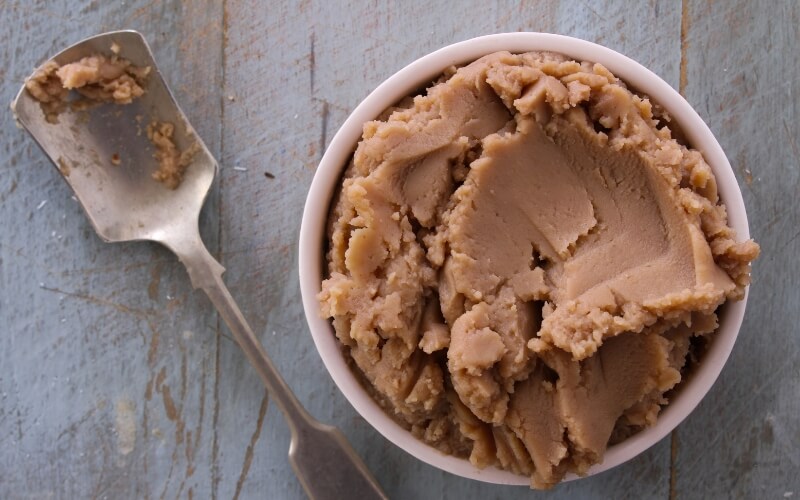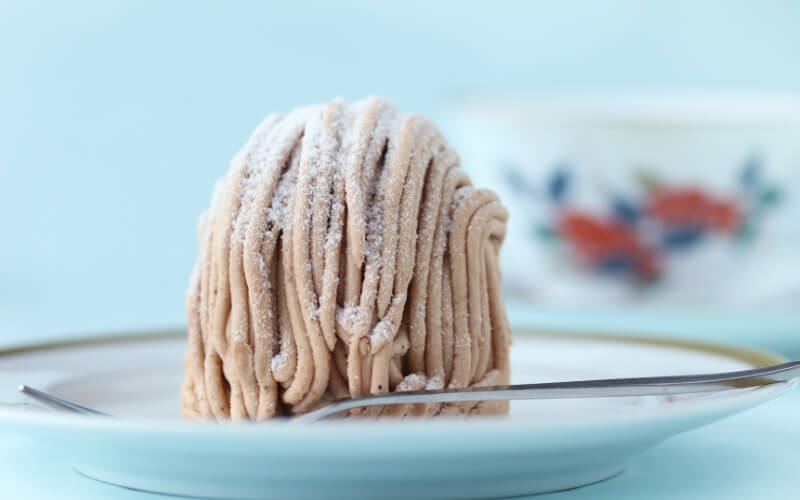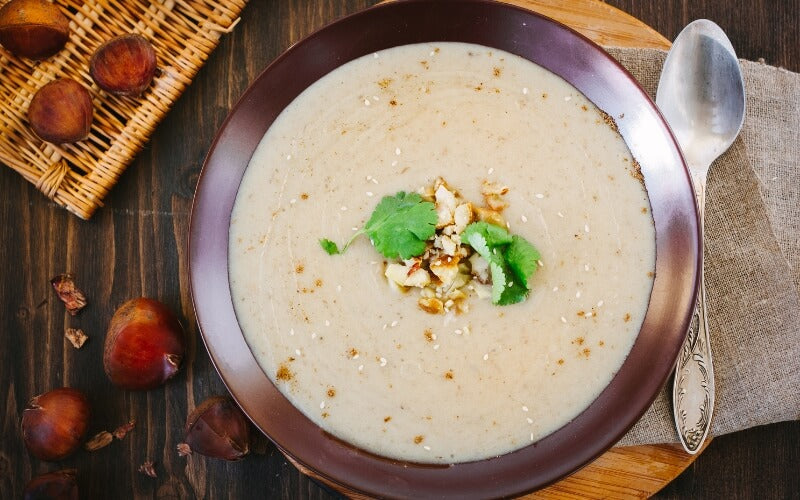It’s a well-known fact that the French love chestnuts. Be it simple roasted chestnuts or luxurious Marron Glaces, candied with extra care and individually hand-wrapped, and everything in between.
The Fall season is unimaginable without chestnuts finding their way onto French menus, be it at fine-dining restaurants or at home.
One of the best hacks ever invented for chestnut-based recipes? The canned chestnut puree. Not only does it cut down about an hour of prep time on average, but it makes it possible to enjoy an excellent chestnut treat, sweet or savory, any time of the year.
Have you added it to your pantry yet?
 What is Chestnut Puree?
What is Chestnut Puree?
Chestnut puree is pretty much what it says on the tin. It’s a thick mass of pureed chestnuts, somewhat reminiscent of peanut or almond butter. What sets it apart from other, more famous types of nut butter is the texture - it’s much thicker than regular nut butter.
The nuts are first boiled and peeled to make the puree, then roasted for deeper flavor and blended. The most straightforward chestnut puree varieties don’t use any ingredients other than water, but others can be sweetened with sugar, flavored with vanilla, or both.
And then, there’s chestnut spread, which is often mistakenly assumed to be chestnut puree but isn’t.
 Chestnut Puree vs. Chestnut Spread: What’s the Difference?
Chestnut Puree vs. Chestnut Spread: What’s the Difference?
It may seem like chestnut puree is just another name for chestnut spread, but there’s quite a big difference between the two.
See, the chestnut puree or Puree de Marrons is simply pureed chestnuts, sometimes additionally sweetened. Chesnut puree has been used in various recipes for centuries.
Chestnut spread, or Creme de Marrons, is an entirely separate product, invented in 1885 by the industrialist Clément Faugier. Clement Fauglier’s chestnuts were already famous by that point, but his primary focus was on Marron Glaces - a beloved but fragile product that was easy to damage.
Fauglier was looking for a way to repurpose broken Marron Glaces he wouldn’t be able to sell but would cost far too much to simply discard (Marron Glaces are, after all, an expensive product).
What he came up with was Creme de Marrons. Damaged Marron Glaces were mixed with sweetened chestnut puree. Basically, Fauglier made thinner chestnut puree flavored with sweet syrup made with water, sugar, and vanilla, with pieces of candied chestnuts mixed in.
Modern Clement Fauglier chestnut puree doesn’t necessarily contain pieces of Marron Glaces. Nowadays, it’s more of a thick and smooth sweet chestnut puree.
 The Top 7 Best Ways to Use Chestnut Paste at Home
The Top 7 Best Ways to Use Chestnut Paste at Home
Having a can of chestnut paste is a quick hack for adding a unique touch to your desserts (and even meals if you don’t have much of a sweet tooth!
It’s easy to store, has a long shelf life, and reduces prep time by a ton, especially for recipes where chestnuts are the main ingredient. For the recipes where the chestnuts don’t take center stage, adding chestnut paste can easily add a new touch. Some excitement, so to speak, if you’ve become tired of old flavor combinations and want to try something new without spending more time and effort than strictly necessary.
Here are seven quickly revitalized recipes if you have a can of Creme de Marrons kicking around in the pantry.
 Try Your Hand at Making Mont Blanc
Try Your Hand at Making Mont Blanc
Mont-Blanc Aux Marrons is one of France’s most famous chestnut desserts, arguably second only to Marron Glaces.
At its core, it’s a straightforward dish: just a heap of sweetened chestnut puree with some whipped cream. The presentation makes this dish unique: the puree is put through a seave to make vermicelli-shaped chestnut puree noodles.
The heavy-lifting part comes with making the puree out of the chestnuts. With your chestnut puree ready to go, you can skip that part (and cut between an hour and two off the cooking time). You can even skip the “putting the puree through the seave” part. You can easily substitute it with a piping bag (you’ll just need a sufficiently small piping tip).
Traditional Mont Blanc desserts didn’t have a base. It was served straight on the plate and topped with whipped cream. Modern Mont Blanc is commonly served either on a thin meringue round or a classic sponge cake base (Japanese bakeries were the ones to popularize this version).
Bake King’s Galette (with Chestnut Paste)
King’s Galette (Galette de Rois) is a version of King’s Cake, a traditional pastry associated with Epiphany in many European countries. Despite sharing the name, King’s Cake looks vastly different depending on the country it’s made in.
In France and French-speaking countries (Luxemburg, Belgium, etc.), it’s a round puff pastry filled with frangipane (almond custard). Unlike more colorful Portuguese Bolo Rei or Mexican Rosco de Reyes, French Galette de Rois traditionally isn’t decorated other than with various patterns cut into the top of it.
Galette de Rois à la Crème de Marron is a less common, yet still quite a famous twist on the original recipe that swaps the classic almond frangipane filling with an almond-chestnut cream. The filling calls for combining around 100g of powdered almonds with 100g of chestnut paste, soft butter, egg, and sugar.
(If you have ready-made puff pastry sheets in your freezer, then the only thing this recipe requires from you is blending the chestnut paste with other ingredients. The galette itself should take only around 30 minutes to bake).
Do You Love Eclairs? Make Some Chestnut Cream Ones
To the surprise of absolutely no one, while chestnut eclairs are not as famous as the more conventional vanilla, chocolate, or caramel ones, there are still plenty of recipe varieties going around. The French do, indeed, love their chestnuts.
The chestnut eclair cream might be among the better entry-point recipes to try if you’re undecided whether you like a chestnut puree or not. It’s a light cream with a subdued chestnut flavor that doesn’t hit the palate as hard as pure chestnut paste.
To make the cream, you’ll need to combine 500g of milk with 100g of chestnut puree in a saucepan and place it over medium heat. While the mixture is coming to a boil, combine three eggs, 50g of all-purpose flour, and 75g of sugar in a separate bowl.
Once the mixture comes to a boil, take it off the heat, let it cool just a little (maybe a minute or two) and add it to the egg mixture. Whisk constantly so that the eggs don’t curdle. Once the mixture looks well combined, return it to the heat. Continue whisking until it comes to a soft boil (it should take no more than 3-5 minutes). Remove from the heat and chill.
Voila, your chestnut cream for eclairs (or any other pastry you’re experimenting with) is ready!
Bake Italian Chestnut Cookies
Let’s leave France for a moment. While the French are known best for their chestnut recipes, Italians are no slouches in this department either.
One of their most noteworthy chestnut products is a cookie called Calzoncelli di Castagne.
Calzoncelli is a common cookie variety in the Vulture region (Basilicata). As the area is also particularly well-known for its chestnuts (particularly the Marroncino type) that thrive best in its volcanic soils, it was only natural for the chestnut filling to become the go-to one for Calzoncelli.
Usually, you’d have to go through the whole process of pureeing the chestnuts the same way you’d have to with Mont Blanc. But if you have a can of chestnut spread kicking around, you can easily swap. Combine the chestnut spread with melted dark chocolate (at about a 2:1 ratio), and you’re pretty much done.
However, some recipes add a few tablespoons of espresso or rum (or both) for a deeper, more complex flavor. Then all you need to do is put a spoonful of the filling on a piece of dough, cinch it tight, and bake until golden brown.
The dough for the cookies is usually straightforward, made with only all-purpose flour, water, lard, or shortening. Some recipes add sugar, but it’s not strictly necessary. The dough should be smooth and homogenous and rest a little (20-30 minutes) before you start rolling it out.
Try Quick Chestnut & Cheese Ravioli
Another enjoyable Italian chestnut recipe, though perhaps not as well-known as Calzoncelli di Castagne, but still well-loved. It’s a Tuscan specialty.
If you prefer savory dishes, then this is a must-try recipe.
To make the ravioli filling, you’ll need the unsweetened chestnut puree. If you’re making a dessert, it doesn’t matter whether you’re using sweetened or unsweetened chestnut spread: you can add sugar (or another sweetener) to make up for the lack of it in the spread. But using sweetened puree for the ravioli filling will render some… interesting results, to say the least. A bit too experimental for our tastes.
The standard filling combines chestnuts, grated parmesan, and fresh ricotta.
As with most traditional recipes, pinning down the correct ingredient ratio is tricky. Some recipes claim that you need almost 2 cups of parmesan per 1 cup of chestnuts, while others say that you need no more than ½ a cup. The amount of ricotta, thankfully, stays at around 4-5oz.
For fairness’ sake (and because we love cheese), we decided to go with 1 cup of parm per cup of chestnut puree and 5oz of fresh ricotta cheese.
Blend the chestnut puree and cheese until completely smooth, and liberally season with salt, black pepper, ½ tsp of fennel seeds, and, optionally, a pinch of nutmeg.
You can make your own ravioli dough, but if you want to cut down on time, even further if you use frozen ravioli dough or good old wonton wrappers.
Put a spoonful of the filling in the wrapper, cinch well, and boil until the ravioli float to the top (about 3-5 minutes). Garnish with more grated parm and toasted butter, and enjoy!
 Make Cream of Chestnut Soup
Make Cream of Chestnut Soup
There are apparently at least two traditional chestnut soup recipes. One is from Italy, called Zuppa di Castagne which uses whole chestnuts, and another is from Germany, called Kastaniensuppe, and it’s basically the cream of chestnut soup without being outright called cream of chestnut soup.
We’ve tried traditional French recipes, and we’ve tried traditional Italian recipes. Now let’s try the German one.
In the original recipe, the chestnuts are boiled, sauteed with butter, then pureed with beef stock, and simmered with other ingredients. In this version, you can jump straight to the simmering part.
Once again, pinning down the correct ingredient ratio is a bit tricky, but after exploring various recipes, it seems 500g of beef stock and 200g of heavy cream per 300g of unsweetened chestnut puree seems like a good ratio for four servings.
Combine the chestnut puree with warm beef stock, and put it on medium heat, bringing it to a gentle boil. Stir until the puree is thoroughly combined with the beef stock. Decrease the heat to low. Add the heavy cream; salt and black pepper to taste, and a pinch of nutmeg to highlight the nutty flavor.
Keep the pot on the stove for about 15 minutes, occasionally stirring. Use a hand blender to achieve a more homogenous texture if the mixture isn’t smooth enough for your taste.
Make a Quick Chestnut Smoothie
And last, but not least, let’s finish up with a quintessential American recipe: a quick breakfast smoothie.
As with all the best smoothies, this one requires only a few ingredients and no more than 5 minutes of your time.
You’ll need about 70g of chestnut puree (whether sweetened or unsweetened is entirely up to you), ½ cup of plain yogurt, a large frozen banana, and (optionally) a splash of your preferred milk.
Combine the yogurt, the sliced or broken frozen banana, and the chestnut puree in the blender. If the mixture is too thick, thin it out by adding a few splashes of your preferred milk (if you prefer plant-based milk, almond will likely work the best for this recipe).
Once the smoothie is homogenous and as thick as you like it, pour it into your favorite cup and enjoy.
You can add ½ tsp of cinnamon and a pinch of nutmeg to the smoothie to give it a deeper, more nutty flavor, although it’s not necessary.


